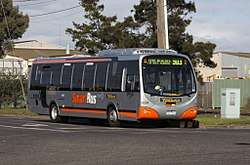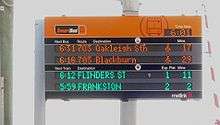SmartBus
SmartBus is a network of bus services in the city of Melbourne, Australia. Overseen by Public Transport Victoria, the network comprises nine key cross-town and orbital bus routes around Melbourne. Key aspects of the service include more frequent services, extended hours of operation to include late evening and Sunday services, improved timetable information at bus stops, roadspace priority along certain routes and priority at particular traffic lights.[2] The SmartBus network was expected to reach 370 kilometres by 2012.[3]
 | |||
| Overview | |||
|---|---|---|---|
| Locale | Melbourne | ||
| Transit type | Bus | ||
| Number of lines | 9[1] (including 3 Orbital and 4 DART) | ||
| Website | SmartBus at PTV | ||
| Operation | |||
| Operator(s) | CDC Melbourne Transdev Melbourne Ventura Bus Lines | ||
| |||
History

SmartBus was originally a policy initiative of the Kennett State Government in the late 1990s, but was slowly implemented under the Bracks and Brumby governments. However, plans from the late 1980s included a number of cross-town routes, which were to be called MetLink.[4]
The first stage of the trial was implemented on 5 August 2002, with the following services being chosen as pilot routes: 703 Middle Brighton to Blackburn and 888/889 Nunawading to Chelsea. These two routes received extra funding for more services, services on 703 increased by 20% and on 888/889 by up to 50%. Sunday services were also added to 888/889. The aim was to find out whether increased services and better reliability would increase patronage. The project was deemed successful when in 2003, on the 1st anniversary of SmartBus, the Victorian Government released a media statement that the SmartBus program increased patronage by 25%.[5]
Three orbital bus lines operate in Melbourne as part of the SmartBus network, they provide cross city links connecting railway and tram lines and other bus routes.
The first orbital route started as a large number of routes (including Route 665 from Dandenong to Ringwood and Route 830 from Dandenong to Frankston ). It was re-launched as the Yellow Orbital Route 901 on 24 March 2008 operating between Frankston and Ringwood. It was extended to Melbourne Airport 26 September 2010, it is Melbourne's second longest bus route(2nd to 684-Melb to Eildon) at 115 kilometres with a journey time of four and a half hours[6] and connects with nine railway stations and over 100 bus routes.
This was followed by Route 700 running between Mordialloc and Box Hill, it was re-launched as a SmartBus on 14 June 2005. On 20 April 2009 it was extended to Altona, becoming the Red Orbital 903, it connects to 11 railway stations and nine tram lines, and is 86 kilometres in length.
Lastly in April 2010 the Green Orbital 902 commenced operations, assuming the operations of route 888/889, it runs between Chelsea and Airport West connecting to nine railway stations, three tram routes and over 60 local lines, spanning 76 kilometres.[7] A Blue Orbital (route 904), was proposed in the 2006 Meeting our Transport Challenges publication, which proposed to service the inner city from Sandringham to Williamstown, however this proposed route was cut from the 2008 Victorian Transport Plan, with the route not mentioned in text or maps.
Doncaster Area Rapid Transit (DART) Routes commenced operation on 4 October 2010. These routes were designed to provide a public transport connection between the Doncaster area and Melbourne City Centre.[7] All were originally operated by National Bus Company, but have been operated by Transdev Melbourne from August 2013 as a result of Transdev's awarding of the Melbourne Metropolitan Bus Franchise.[8]
Routes
The SmartBus network consists of three orbital routes, the radial Doncaster Area Rapid Transit (DART) route group and two shorter non-orbital routes.[9]
Features

SmartBus aims to provide a premium bus service to commuters with quality stops and tram-like frequencies. Service improvements include the following:
- Services are higher-frequency than many bus routes in Melbourne. Weekday service levels are, on average.[10]
- every 30 minutes between 05:00 and 06:30
- every 15 minutes between 06:30 and 21:00. Additional peak services operate along sections of Routes 703, 901 & 903, while Routes 900, 905, 906, 907 & 908 operate every 10 minutes or better during peak periods.
- every 30 minutes between 21:00 and midnight
- Weekend service levels are, on average:
- every 30 minutes between 06:00 and midnight on Saturdays and public holidays. Route 903 operates an additional service each hour between Box Hill & Mordialloc on Saturday afternoons.
- every 30 minutes between 07:00 and 21:00 on Sundays, Good Friday and Christmas Day.
- Route 900 (Caulfield - Rowville) operates as a limited stop service, while 703 offers limited stop express services between Blackburn & Monash University during peaks for students changing from the Belgrave, Lilydale & Glen Waverley lines & 75 tram.
- Real-Time Passenger Information Displays are available at selected bus stops along SmartBus routes, especially at major road intersections and bus interchanges, although real-time information is not available at all stops. Most stations along the routes have PIDs.[11]
- In some sections of SmartBus routes, buses are given priority at signalised intersections, for example by extending the green time or reducing the red time for that direction in the intersection when a bus is approaching.[11]
- Limited dedicated bus lanes are in operation on most routes. The DART bus routes have a dedicated bus lanes on Hoddle St in the AM peak along with Lonsdale Street in the City in the peak direction. Buses are also able to use the emergency lanes along the Eastern Freeway to bypass heavy traffic common during peak periods.
- There are some priority "head start" lanes at various intersections that allow buses bypass traffic queues and then enter the intersection before other traffic. Major roundabouts have special slip lanes that allow buses to skip queues and having to give way to the right.
- Bus stops that comply with the Commonwealth Discriminatory Act, with tactile tiles and better signage, as well as lower ground to allow the elderly or wheelchair-using passengers easier access to buses.[12] Stops also feature totem poles with timetables & maps.
- Indented bus bays have been removed, with bus stops moved to the left-hand traffic lane to allow buses to depart stops without delay once passengers have boarded. Some closely located stops have also been consolidated to reduce delays.
- All services operate with low floor buses with ramps to accommodate elderly and wheelchair-using passengers. Buses were originally in a special silver & orange livery to promote the routes, however newer buses do not feature this livery, simply using the standard PTV orange livery, although they are still fitted with the internal SmartBus PIDs (LED displays and automated announcements). If a SmartBus vehicle is not available due to lack of vehicles at a depot, a regular bus will run as a substitute, however these buses are not fitted with SmartBus PIDs.
- Electronic "next stop" signage on each bus which displays and announces the next stop. These announcements cut-in commercial radio broadcasts.
SmartBus patronage growth
Several reviews have been conducted of patronage growth on SmartBus routes. A review of routes 703, 903 (formerly route 700) and 902 (formerly 888/889) found that boardings increased between 15% and 60%, five years after the services were upgraded.[13]
In 2010 the Bus Association of Victoria found that SmartBus patronage on routes 703 and 902 (formerly 888/889) increased 15% over two years. This increase was higher than other upgraded (but non-SmartBus) bus routes in Melbourne (13%) and significantly higher than non-upgraded routes (6-7%).[14]
See also
- Metrobus (Sydney) - a series of cross-regional bus services introduced in Sydney between 2008 and 2011
References
- "Network statistics". Public Transport Victoria. Retrieved 26 May 2013.
- http://ptv.vic.gov.au/projects/buses/smartbus/
- Lucas, Clay (14 July 2008). "SmartBus plan 'will not work in current form'". The Age. Retrieved 28 March 2009.
- W. A. Doubleday (July 1988). "The May Intermediate Draft MetPlan". Newsrail. Australian Railway Historical Society. p. 200.
- Media release: Outstanding performance marks first anniversary of SmartBus
- Carey, Adam (27 October 2013). "901 bus service 'flawed'". The Age. Archived from the original on 13 April 2014. Retrieved 28 October 2013.
- "SmartBus map and routes". Department of Transport. 2 April 2011. Archived from the original on 26 February 2011. Retrieved 9 June 2013.
- "Preferred tenderer announced for the Melbourne Metropolitan Bus Franchise". Public Transport Victoria. Retrieved 9 June 2013.
- "SmartBus Network" (PDF). Public Transport Victoria. 31 August 2010. Retrieved 4 July 2019.
- Public Transport Victoria (2009). "Fact Sheet: What is SmartBus?" (PDF).
- Public Transport Victoria (2009). "Fact Sheet: SmartBus Technology" (PDF).
- Public Transport Victoria (2009). "Fact Sheet: SmartBus Bus Stops" (PDF).
- C Loader & J Stanley (2009). "Growing bus patronage and addressing transport disadvantage — The Melbourne experience". Transport Policy. 16: 106–114. doi:10.1016/j.tranpol.2009.02.001.
- BusVic (2010). "Bus Solutions" (PDF).
